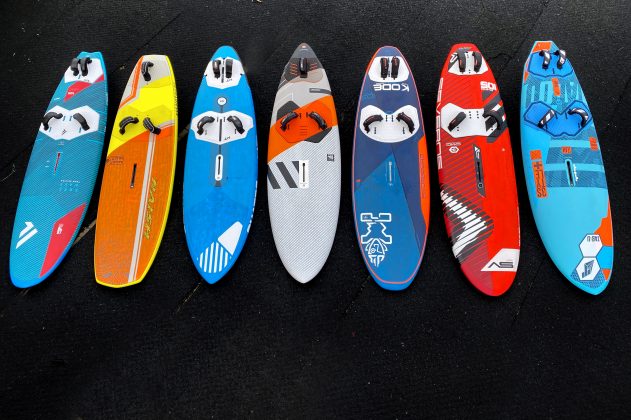From our March 2021 issue of Windsurf Magazine, despite Brexit and Covid-19 affecting supply lines, the test team got their hands on some of the latest 105 litre crossover boards to test.
Test editor: Tris Best // Second Testers: Joe North And Maurin Rottenwalter // Photos: Alex Best // Test Location: Overcombe And Portland Harbour
105L CROSSOVER BOARD TEST
Testing in the UK during the winter months is always a bit of challenge. Dropping air and water temperatures provide the obvious hurdles, but more than this, the squally conditions and often fluctuating winds create discrepancies of their own, making it hard to set controls and really quantify results. The answer is simply to remain disciplined … and spend more time on the water, which, given the world we’re living in at present, was a task our test team willingly accepted!
The truth is that crossover boards in these conditions are the perfect go-to platforms. Super versatile, they can handle the most diverse conditions and adapt to differing roles, meaning that they have the capacity to meet any change in weather head on. In many respects winter conditions provide the perfect test environment for these boards; a real-world challenge of making the most of the time we had on the water.
FINDINGS
The first point worth noting is that many of the boards here are unchanged from last year. Many brands are adopting extended life cycles, be it over two or even three seasons; the visuals and fittings may change, but the designs remain the same. As such, the evolution in crossover design is subtle and nuanced, and tends to be led by concepts and theories played out in the products of other disciplines, such as wave or slalom. The ‘compact’ concept, for example, first came into play in the wave arena and filtered coherently through to the crossover scene the following season. An over-exuberance of enthusiasm for a concept usually results in a rescission in subsequent years, where contemporary then meets conventional somewhere in the middle and a new happy median is established.
In the seven boards on review here, there’s a healthy mix of design ideologies. Some place the rider’s stance rearward, right over the fin, with more parallel outlines and plenty of width in their tails. There are a few that defy the populist ‘compact’ rationale and opt for narrower tails, moving the rider’s stance further forward towards the nose of the board. And then there are some that sit in the middle, adopting design elements from both camps; a sort of hybrid balance of features with the unapologetic intention of appealing to the widest audience possible.
SUMMARY
Glance quickly at the Quatro Power Pro and you’d be forgiven for thinking that it’s an overgrown wave board. Deceptively fast across the water, it has a silky rail-to-rail nature and feels much smaller than its quoted volume on the wave face. RRD have rejuvenated their Freestyle Wave offering and in doing so have bravely parted ways with their safe ‘high-wind freeride’ formula. The all-new 104 is a triumph in many ways and provides much more appeal for the experienced demanding rider, most noticeably in its carving prowess. If the Quatro and RRD place the rider’s stance forward, then Naish and Severne do the very opposite, shifting everything to the rear. And equally, there is a very different approach between these two contenders – just compare their two bottom shapes and you’ll get a clear understanding! The Assault is a super easy, ‘nothing too complicated’ ‘plug and play’ apostle, the Dyno a master of detail and tweaking. If you enjoy the finer tuning precision of equipment, there is plenty to get your teeth into, and bags of performance to exploit. Starboard’s Kode is incredibly adaptable too, comes with two complete fin setup options and a graphical key to help walk you through its tuneable range. Lively, yet controllable and compact, it feels quite special in its Reflex Carbon construction and has a special price tag to boot! And finally, to the two real all-rounders of the group – the Fanatic and Tabou. Both are hybrids of old and new, taking in vogue elements of design and mixing them with the time-honoured. The FreeWave, with its wide swallow tail and rearward stance, has a long rail line and can turn off front or back foot. Captivating, fast and active, its setup doesn’t require any in depth scrutiny or study, working in all roles, straight out of the box with its supplied fittings. The 3S+ is the oldest design in this test group, entering its third season. Providing a smooth, tempered ride, it has the capacity to respond to any riding style from passive to the most powerful and aggressive. Testament to just how good a design it is, it feels as current today as it did when it was first introduced.
105L CROSSOVER BOARD TEST
THE LINEUP
STARBOARD KODE REFLEX CARBON 105

